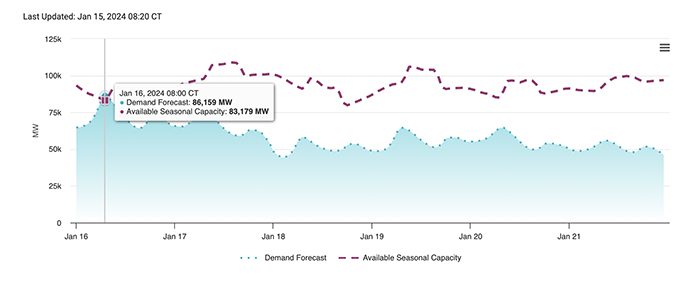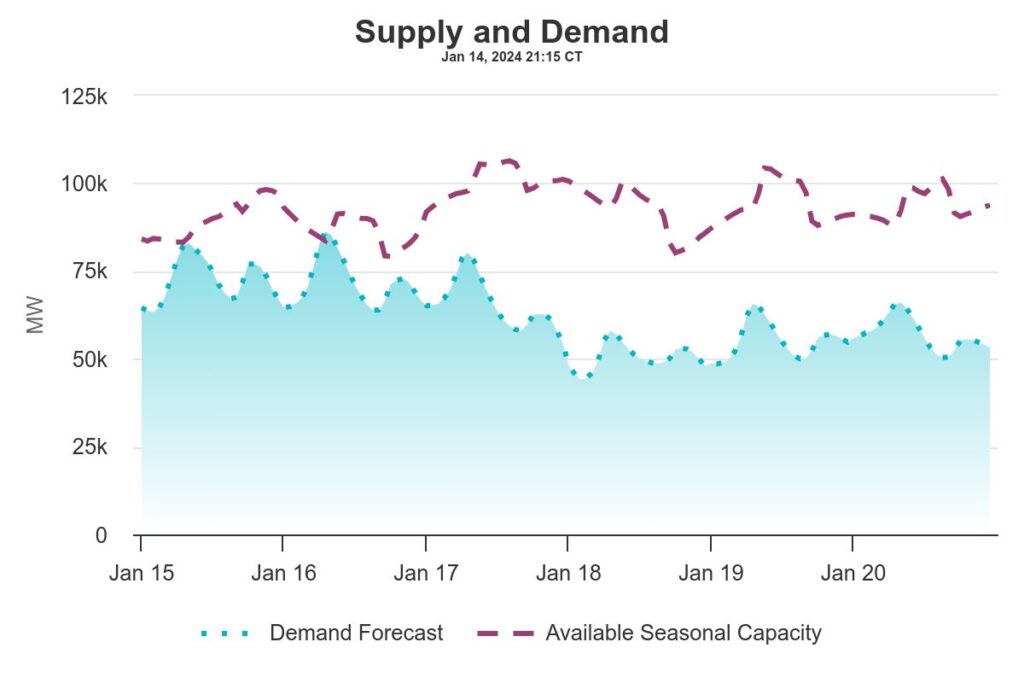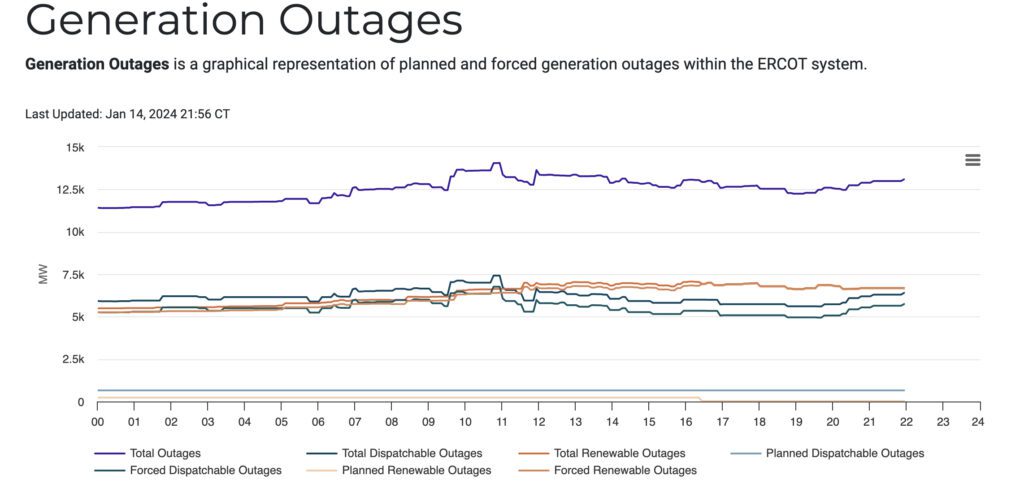ERCOT Warns of ‘Tight Conditions’ as Intense Freeze Grips Texas
The Electric Reliability Council of Texas (ERCOT) has issued a conservation appeal as it braces for continued freezing temperatures, “very high” demand, and “unseasonably low wind” early in the morning on Jan. 15, just before the solar ramp-up.
The grid operator on Sunday afternoon said it expects “tight grid conditions” as temperatures plunge, driven by an arctic outbreak, across the Texas and Oklahoma Panhandles. Extremely cold air is expected to affect a large portion of Texas beginning late on Sunday (Jan. 14) and continuing through Tuesday (Jan. 16).
ERCOT said it expects even tighter conditions on Tuesday and “will continue to closely monitor conditions and keep the public informed through our communication channels.” Monday marks Martin Luther King Jr. Day, a federal holiday in the U.S. While the freezing weather may prompt business closures on Tuesday, as of 8 a.m. on Jan 15, ERCOT was forecasting a supply deficit of about 3 GW for 8 a.m. on Tuesday.

ERCOT on Monday noted it broke its all-time winter peak demand record with 75,559 MW in the 9-10 a.m. hour. ERCOT’s all-time peak demand record of 85,508 MW occurred on Aug. 10, 2023. The grid operator has noted a huge influx of solar has shifted energy emergency risks to early mornings, before the solar ramp-up, or to late afternoon or early evening, when solar production diminishes. “Solar generation isn’t available in the early morning hours, which is a peak demand time during winter, and slowly ramps up as the sun rises,” it noted.
A conservation appeal, part of Texas’s Advisory and Notification System, is a mitigation step the grid operator takes to increase its operating reserves if it determines that the cushion between available power generation supply and customer demand is risky. It is not, however, considered an emergency.
“Conservation is a widely used industry tool that can help lower demand for a specific period of peak demand time, which is typically during the morning hours in winter,” the grid operator noted. The appeal issued on Sunday afternoon urges all government agencies, including city and county offices, to implement programs to cut their energy consumption.
ERCOT, Texas Mobilizing All Efforts for Reliability
Texas has been preparing for the extreme cold event to prevent a debacle like Winter Storm Uri, a four-day freeze in February 2021 that prompted perhaps the most sobering U.S. electric reliability crisis in recent decades. Winter Storm Uri, notably, triggered the loss of 68.1 GW of generation in ERCOT, Southwest Power Pool (SPP), and the Midcontinent Independent System Operator (MISO).
According to the Public Utilities Commission of Texas (PUCT), ERCOT will use “all available tools to manage the grid reliably, including using reserve power, calling upon reductions by large electric customers that have volunteered to lower their energy use, and bringing more generation online sooner.” In addition, the grid operator has requested Texas Commission on Environmental Quality enforcement discretion, approval that would allow a generator “to extend its service/run-time/operations to help meet demand, if needed, and maintain grid reliability,” it said.
ERCOT is also working with neighboring Independent System Operators (ISOs) and market participants to obtain additional power generation capacity, the PUCT said on Sunday. However, it is unclear how much power the grid may be able to procure. SPP on Jan. 12 issued a Conservative Operations Advisory in addition to the two previously declared advisories for its entire balancing authority from 4 a.m. on Jan. 14 through 9 p.m. on Jan. 16. MISO also declared “Conservative Operations” beginning Jan. 13 through Jan. 17.
During a press conference on Jan. 12, ERCOT President and CEO Pablo Vegas said the Texas grid is “better prepared than it has ever been before.” ERCOT has completed 1,800 inspections of generation and transmission facilities among other measures, he noted.
Generators Should Have Implemented Winter Readiness Plans
All generating entities in ERCOT, notably, are required to complete weather emergency preparation measures and maintain them through the season. The winter readiness plan, for example, requires the installation of windbreaks that can bear high winds, measures to protect cold weather critical components (CWCCs) from freezing (for example, with insulation and enclosures), and functional testing of heat trace equipment. The plan also calls for cold weather operations training, including through checklists and drills.
Generators must also comply with cold weather standards issued by the North American Electric Reliability Corp (NERC). Though those standards are under revision to integrate other recommendations, such as findings from Winter Storm Elliot, NERC says it continues engagement in cold weather preparations. NERC last week said in a statement that while it was monitoring the arctic cold, it urged generators, fuel suppliers, reliability coordinators, balancing authorities, and transmission operators to evaluate energy adequacy. It also urged load-serving entities to review demand projections to ensure reliability. “Securing fuel supplies, readying units through winterization, and dispatching fuel will require prudent attention throughout the long, holiday weekend,” it underscored.
As part of its winter preparedness, ERCOT notes it has also worked with generators and transmission operators to schedule maintenance after “running hard” during the eventful summer of 2023. Along with forecasting improvements, ERCOT has implemented a contingency reserve service, which takes advantage of resources that can start up within 10 minutes to address unexpected or rapid changes in supply or demand.
In addition, it has taken specific steps to ensure the natural gas supply will remain reliable. Among recent measures, ERCOT has implemented a PUCT order to procure Firm Fuel Supply Service Resources (FFSSRs) to provide Firm Fuel Supply Service (FFSS) to maintain resource availability in the event of a natural gas curtailment or other fuel supply disruption.
Demand Currently Slated to Outstrip Supply on Tuesday
Still, ERCOT’s Supply and Demand dashboard suggests the next two days may be precarious. As of Jan. 14, demand is forecast to peak at 82.2 GW on Monday (Jan. 15) at around 8 a.m., while available seasonal capacity—which includes forecasted committed capacity, current committed capacity, and additional available capacity—stands at 83.2 GW. And for now, ERCOT is forecasting a deficit on Tuesday morning at around 8 a.m. (Jan. 16), with a projected demand of 86.3 GW and an available seasonal capacity of 83.6 GW.

Industry observers on Sunday night offered up various scenarios for what could happen over the coming week. On X (formerly Twitter), Doug Lewin, founder of Stoic Energy Consulting, suggested four major factors contribute to the likelihood of rolling outages: “demand, gas supply, gas & coal plant outages, & renewable output.” So far, he tweeted, “gas supply is down ~9%. It was down ~20% in Uri & about 18% in Elliott (Dec. ‘22) nationally (drops are usually larger in the Permian).”
ERCOT on Monday at 8 a.m. said wind resources are hovering at about 4.7 GW. That compares to an hourly average of 9.2 GW on Jan. 14. As of 10 p.m. on Sunday, ERCOT’s dispatchable generation outages stood at 6.3 GW—5.6 GW which were forced outages. Forced renewable outages amounted to 6.7 GW.
On Monday at 8 a.m., forced dispatchable outages hovered at 6.4 GW, while forced renewable outages stood at 8.3 GW. “This is a big test for the PUC’s weatherization rules,” Lewin added. “If outages stay around 5 GW, we’re probably fine. If more go offline, maybe not.”

—Sonal Patel is a POWER senior associate editor (@sonalcpatel, @POWERmagazine).
Updated (Jan. 15, 2024, at 8 a.m. CST)—Adds figures from ERCOT’s Generation Outage and supply and demand dashboards.